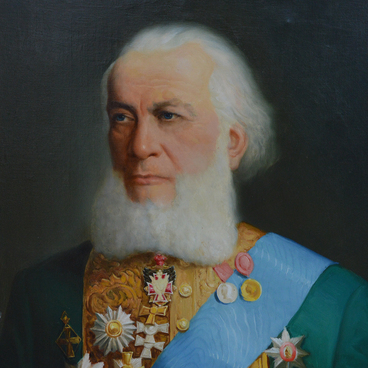The picture depicts the architect A. P. Tryasova — this portrait was painted in 1936 by Vera Semyonova-Tyan-Shanskaya, the granddaughter of the geographer Pyotr Semenov-Tyan-Shansky. She was a painter and graphic artist, was in the Leningrad branch of the Union of Artists.
Her father was Dmitri Semyonov-Tyan-Shansky, a statistical scientist and specialist in agriculture. He was also an active member of the Geographical Society and headed the statistics department in it: he participated in organizing the first population census of the Russian Empire and preparing industrial and agricultural exhibitions.
Vera Semyonova-Tyan-Shanskaya was educated at the Drawing School of the Imperial Society for the Promotion of Arts in St. Petersburg and the State Institute of Art History. Afterwards she worked a lot in the field of design art. In particular, she was a senior artist-designer at the Museum of Anthropology and Ethnography of the Academy of Sciences in the department of Asia and North America.
For the first time, Vera Semyonova -Tyan-Shanskaya demonstrated her works at the exhibition of drawing and print at the Saint Petersburg Academy of Arts in 1909, presenting a portrait of her grandfather to the public. From 1910 to 1917, she actively exhibited with the ‘New Society of Artists’ team, which was founded in St. Petersburg in 1903 and existed until 1918. After the Bolshevik Revolution she became a member of ‘Community of Artists’, and even later joined the society ‘Workshop of Artists’. In 1939, a large personal exhibition of the artist’s works was held in the Central House of Art Workers. She exhibited more than seventy of her works.
During the Great Patriotic War, the artist was in besieged Leningrad and took an active part in preserving the cultural monuments of the city, continuing to work on her own works.
Vera Semyonova -Tyan-Shanskaya left memoirs that perfectly convey the atmosphere of artistic life in the first half of the 20th century. They were partially published. She also did a lot to popularize the works of her grandfather. For example, she was the initiator of the opening of the Pyotr Semyonov-Tyan-Shansky Memorial Museum in the village of Gremyachka, Ryazan Region. Today his collection contains literature, scientific works, and the true things of the scientist.
The artist died in 1984 in Leningrad in the year of her 102nd birthday. Today her works are in many state museums and private collections in Russia and abroad.
Her father was Dmitri Semyonov-Tyan-Shansky, a statistical scientist and specialist in agriculture. He was also an active member of the Geographical Society and headed the statistics department in it: he participated in organizing the first population census of the Russian Empire and preparing industrial and agricultural exhibitions.
Vera Semyonova-Tyan-Shanskaya was educated at the Drawing School of the Imperial Society for the Promotion of Arts in St. Petersburg and the State Institute of Art History. Afterwards she worked a lot in the field of design art. In particular, she was a senior artist-designer at the Museum of Anthropology and Ethnography of the Academy of Sciences in the department of Asia and North America.
For the first time, Vera Semyonova -Tyan-Shanskaya demonstrated her works at the exhibition of drawing and print at the Saint Petersburg Academy of Arts in 1909, presenting a portrait of her grandfather to the public. From 1910 to 1917, she actively exhibited with the ‘New Society of Artists’ team, which was founded in St. Petersburg in 1903 and existed until 1918. After the Bolshevik Revolution she became a member of ‘Community of Artists’, and even later joined the society ‘Workshop of Artists’. In 1939, a large personal exhibition of the artist’s works was held in the Central House of Art Workers. She exhibited more than seventy of her works.
During the Great Patriotic War, the artist was in besieged Leningrad and took an active part in preserving the cultural monuments of the city, continuing to work on her own works.
Vera Semyonova -Tyan-Shanskaya left memoirs that perfectly convey the atmosphere of artistic life in the first half of the 20th century. They were partially published. She also did a lot to popularize the works of her grandfather. For example, she was the initiator of the opening of the Pyotr Semyonov-Tyan-Shansky Memorial Museum in the village of Gremyachka, Ryazan Region. Today his collection contains literature, scientific works, and the true things of the scientist.
The artist died in 1984 in Leningrad in the year of her 102nd birthday. Today her works are in many state museums and private collections in Russia and abroad.



